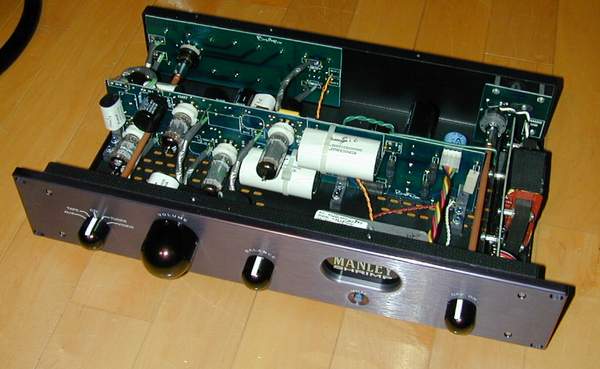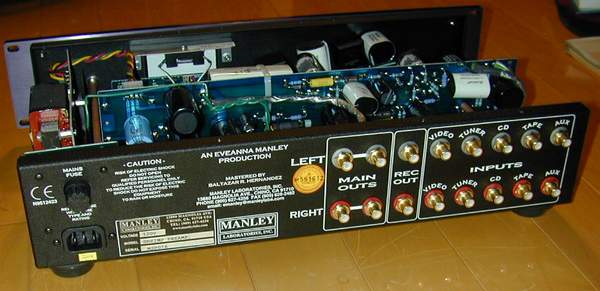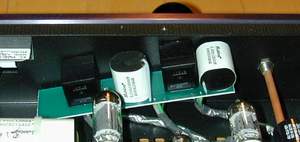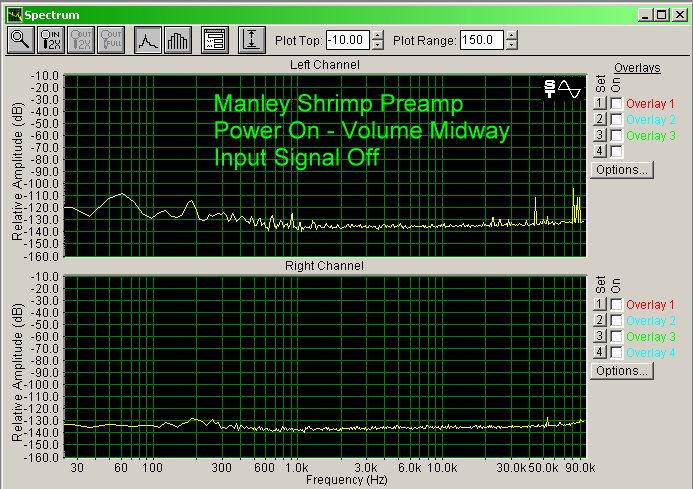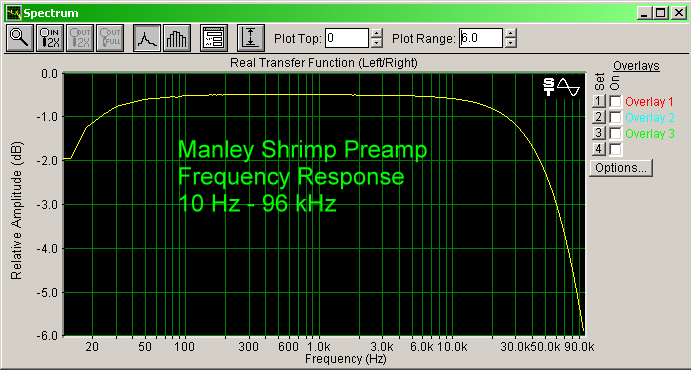|
||||||||||||||
|
Introduction Tubed audio gear is different than solid state gear, and while that might seem like an obvious statement, it is something you need to consider if you have never owned tubed equipment before. Not only do tubes sound different than solid state, their topology is different, they need more ventilation and require more maintenance (replace tubes, adjust bias voltages, etc.) In the 60s, hi-fi audio equipment, which was normally tube based, took a mass transformation to the solid state gear that makes up the majority of the hi-fi products we have today. The reason for this was not because solid state gear sounded better (especially in the 60s), it was because of the promise of zero maintenance, higher power output in smaller packages, cleaner signals (which may be better from an engineering standpoint, but not necessarily from our ear's perspective), and of course just the lure of something new. Of course, solid state hi-fi became less expensive to manufacture, too. It is similar to what we may go through in the next couple of years with the onset of digital amplification. To be truthful, from a technology standpoint, there is not much of a reason to use tubes anymore, except maybe to listen to music during an ElectroMagnetic Pulse (EMP) caused by a nuclear explosion (tubes are not susceptible to an EMP like solid state devices). So, why do many audiophiles still buy tube gear? It sounds great! Keep in mind that transistors were initially designed for computer switching, not audio (bipolar devices were for audio, while FETs were for switching). Tubes on the other hand, were designed entirely for music. In the world of technology, it is almost feasible to build a perfect amplifier from an audio perspective. The problem is the designer has no idea what you will be connecting the amplifier to or what type of room you will be using it in. While there are plentiful reasons why we perceive audible differences in equipment, the interactions of your equipment and the listening environment are the biggest factors. For instance, in one of my setups I have hardwood floors, a large glass window, and only minimal sound damping furniture to soak up all the reflected sound bouncing around the room. While it would be nice to just fix the environment, my wife would not be impressed by my putting some old carpet over the floor and attaching wedged foam shapes to the walls. We do have three Samoyeds (very furry medium sized dogs) which if strategically placed on the floor can help to an extent, but the trick of course is getting them to stay there. For years I have tried different setups in this environment. Some worked and others didn't. My wife seems particularly sensitive to bright gear and I have to admit I too find that listener's fatigue sets in pretty quick with some of the solid state gear I have used over the last few years. Some time ago, I decided to try a new approach. I built a Bottlehead Foreplay preamp that had tubes. It was an uplifting experience. For $250 I built the Foreplay with all the common upgrades and a few more. I was impressed. For the first time I understood why for over 40 years people were still using tubes. The sound was almost holographic and so easy to listen to I never wanted to stop. I built my Foreplay in several stages continually upgrading and trying new combinations of tubes, caps, and attenuation circuits. After several months, I had to retire this preamplifier because my wife and I missed having a remote. So, I then spent much more money on a remote controlled tube preamplifier. So Look Here
With that preface, I report here on the Manley Shrimp. This little single ended line stage has to be a tube builder's dream. It has all the right parts inside and out, as well as an almost nostalgic look about it. Notice that there really are not that many components in there. This is one reason tubes sound so good. They use high voltages, so they don't need a lot of support circuitry. With so little in the signal path, there is less to get in the way of the music. So, why does tube hi-fi cost so much? Because they are hand made in small quantities. This is definitely not mass market. The Externals The Shrimp is well built and is a heavy unit for the size. It has a 3/8” thick aluminized face plate with rack mount holes pre-drilled, along with some very heavy gloss black metal knobs and a back lit logo that remind me of a radio built in the 40s. The perforated metal cover allows for plenty of air flow and a hint of glowing tubes if you are looking down on it. Manley has chosen high quality gold plated RCAs for all the inputs and outputs. The detachable power cord is of the standard IEC type and is easily upgradeable for the people that go for that sort of thing. All controls have a tight solid feel to them with no slack or play. Turning the unit on and off or for input selection has a strong solid 'click' as the selector engages the proper connection. There are only five controls on the front of the unit, which allows for easy operation. From left to right these are input selection, volume, balance, mute and power. Engaging the mute circuit is confirmed by illuminating the small blue button which also doubles as a warm up indicator when the unit is powered on. On the back side of the Manley there are five inputs, a tape loop and two sets of outputs. The outputs are in parallel, so you should check with the manual to make sure you are not going to run into impedance issues if you are connecting two power amplifiers. Since the output impedance of the Shrimp is a very low 70 ohms and has a high current output stage, as long as your total load impedance is above 2000 ohms, you won't have any trouble driving most amplifiers or several of them. The Shrimp is quite appealing to look at. The retro appearance is part of the Manley stable, and is something that tube aficionados like. The Internals
The internals of the Shrimp are typical for a company that gets caught up in the quality of parts inside audio equipment. It starts with high quality Noble pots for both the volume attenuation and balance control. It sports MIT multi-caps throughout the signal path. It is worth noting the 30 microfarad caps on the outputs are half as large as my fist. In all my thoughts of upgrading output caps in the Foreplay, something of this nature never crossed my mind. Only a word like WOW can possibly do them justice. For tubes, Manley has chosen to use 12AT7s on the input and 7044s on the output stage. The 12AT7s are a great choice, as they are probably one of the least commonly implemented tubes in the 12A*7 series. From my perspective this is a good thing. NOS (New Old Stock) versions of the more common 12AX7 and 12AU7 tubes are getting quite expensive, while the 12AT7s can still be found in pairs for under $10, and even for the most exotics will probably only run you $35. I am less familiar with the 7044s, but Manley obviously chose them for good reason as they work great in this combo. You will have a little harder time finding replacement 7044s if you are a tube swapping kind of person. The 7044s are a newer version of the 12BH7, and while they do exist, you will not find them in 50 auctions a day on eBay. Manley carries a large stock of tubes, so there are no worries about getting replacements when you need them. As for the rest of the Shrimp's internals, it is well built. The odd screw or nut does sometimes come loose and float around inside the unit after UPS has its way with it. I was the second reviewer of this unit and had to find a spot for one of those floating nuts after the unit arrived. Manley must have this happen from time-to-time as I noticed a question on their FAQ dealing with this exact topic. Supporting Documentation If you buy a Manley product, it is worth going to their website to read their history, FAQs, and even the odd story about broken wrists and catching rats (seriously go read for yourself). I had a great time reading through their website and the manual for the Shrimp. There were a couple of times I broke out laughing. The Manley website reads more like a story than a marketing message and is certainly not your typical public relations ploy. It is filled with some interesting little anecdotes, but it was mainly the sarcasm that cracked me up. I like a person who is not afraid to use a little sarcasm from time-to-time, and EveAnna Manley (CEO of Manley) is a rocket! Had I purchased the Manley, I probably would have never even opened the documentation, as it is simple to set up and operate. However, if you purchase a Manley product you need to read the warranty information and fill out the registration form supplied, or the on-line version, in order to extend your warranty beyond 90 days. Provided that condition is met, you will receive 5 full years of warranty. The Sound I could say, "The Manley has a warm rich midrange without sacrificing detail or low frequency drive," but I am not going to follow that typical reviewer's path, even though that is a good statement to describe the Shrimp. Instead, I am going to give you a little more technical description of the sound. First off, the Shrimp is attenuated just slightly, and I mean slightly, at both ends of the frequency spectrum. In the world of tubes, you might hear a description of lush or warm midrange, since if you roll off the top and bottom you end up with forward mids. Now some of you might think this is a bad thing. Believe me it isn't. Remember above where I talked about my room with the hardwood floors and glass windows. Rolling off the top in this case tames some of the brightness the room creates. Or have you ever spent a few hours listening to your super detailed speakers and solid state amps to find your ears hurt? I have, over and over. The one thing I find with tubed equipment is it gives me the ability to listen to music forever with no listener's fatigue. Part of the reason is the just slightly rolled off upper frequency range. Now you might ask, "What about the bottom of the frequency range?" You are possibly thinking, “I love bass, I don't think I would want any of that taken away, as I just spent a fortune of those huge floor model speakers”. Well, even floor-standers rarely go down to 25 Hz. Regardless, I seriously doubt you will notice the minimal roll-off of the Shrimp. That brings me to the next tube generalization I would like to squash. Some people have the belief tubes sound slow or mushy in comparison to their solid state counterparts. This is an unfair bias, because the majority of tubed equipment I have owned sounded just as tight and fast as any solid state gear I have owned. There are always exceptions and if you buy a piece of vintage tubed equipment where the caps dried up years ago and the quality and tolerance of the parts were not what they are today, you might experience terrible audio. Modern equipment, tubed or solid state, has no need to sound soft unless the designer has made that choice on purpose or it is a poor design to start with. Well, the Shrimp sounds superb. It is warm and rich without sacrificing a tight bottom end. It has dimension well beyond the edges of the speakers. Its soundstage is deep, while the last two solid stage preamps I have owned have been very upfront in their presentation. The Manley pushes the soundstage back behind the speakers a little, right where I like it. The Manley is a real joy to listen to, especially in my living room. I used this preamp as part of my daily system for over a month and at no time did I even consider switching it for something else. The Measurements Now that the fluffy stuff is over, let's take a look at the measurements that JJ did on the bench. With a 1 kHz sine wave on the input, the output shows 0.07% THD, which is fine for a tubed linestage preamplifier. You can see the small 2nd and 3rd order harmonics present in the graph below. Notice that the 2nd harmonic is larger than the 3rd. This is what you get with tubes, and is good. Part of that lush tube midrange is the preponderance of even ordered harmonics, compared to many solid state products that produce mostly odd ordered harmonics (odd ordered harmonics are very irritating to listen to).
Using the combined 11 KHz and 12 KHz signals, there is 0.04% THD.
The noise floor of the Manley is excellent. With the volume midway (again slightly higher than a typical listening level with most equipment), the noise level is nearly at the baseline limits of our sound card. The can be verified in a more practical sense by placing your ear in front of the speaker. This is a very quiet preamp. I am accustomed to tubed gear having a slight hum or hiss that is usually audible from a foot or two away. The Shrimp has no such annoyances.
Lastly we take a look at the frequency response. As you can see, there is a very slight 0.5 dB roll-off at 20 Hz and about 0.25 dB at 20 kHz.
Conclusions The Manley Shrimp preamplifier is exactly what striving for the best is all about. There is not a spot where the Shrimp is lacking from the inside to the outside. Solid state preamps around the same price might have balanced outputs, 12 volt triggers, phono stage, and remote control. Most of these I can easily live without, but I really did want a remote control. Anyone in the market for a tube preamplifier should audition this product, because sound is what it is all about, not whether you can operate it like a couch potato.
- Sandy Bird -
Associated Equipment:
|
||||||||||||||


